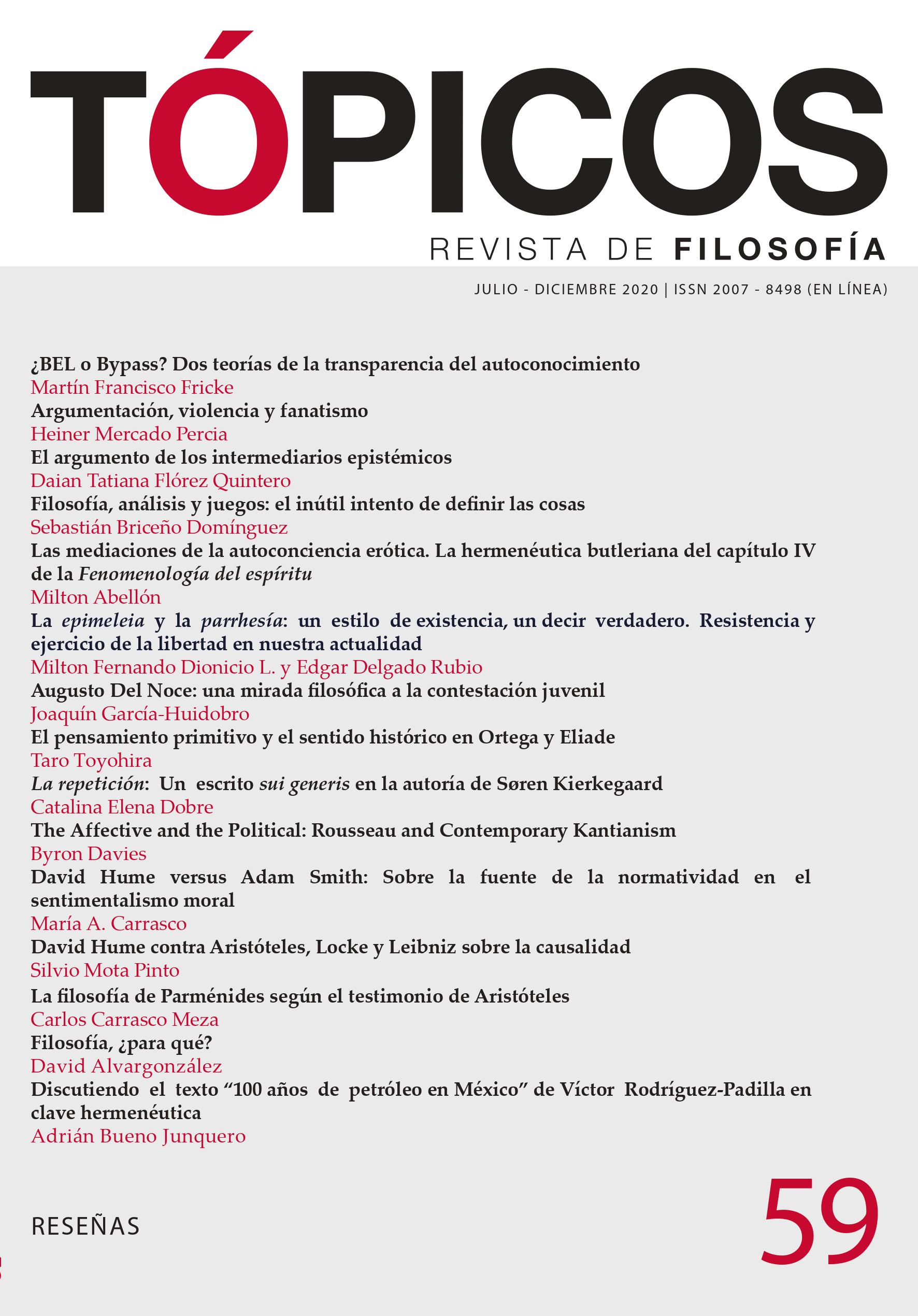Artículos
Publicado 2020-06-27
Palabras clave
- Adam Smith,
- David Hume,
- sentimentalismo moral,
- autoridad normativa,
- razones morales
Cómo citar
Carrasco, M. A. (2020). David Hume versus Adam Smith: Sobre la fuente de la normatividad en el sentimentalismo moral. Tópicos. Revista De Filosofía, 59, 341-366. https://doi.org/10.21555/top.v0i59.1114
Resumen
A pesar de las muchas semejanzas entre las teorías morales de David Hume y Adam Smith, en los últimos años muchos han comenzado a interpretar la Teoría de los sentimientos morales de Smith como una respuesta crítica a la ética de Hume. En este artículo propongo que la diferencia más importante entre estos sentimentalistas se relaciona con el origen y la naturaleza de la autoridad normativa de la moral, que a fin de cuentas determina qué se entenderá por una legítima razón moral, o qué es propiamente la moral.
Descargas
Los datos de descarga todavía no están disponibles.
Referencias
- Cohon, R. (2008). Hume’s Morality: Feeling and Fabrication. Oxford University Press.
- Darwall, S. (2006). The Second-Person Standpoint, Harvard University Press.
- Darwall, S. (2010). Precis: The Second-Person Standpoint. Philosophy and Phenomenological Research, 81(1), 216-228.
- Elton, M. (2017). Crítica de Thomas Reid al sistema de la simpatía de Adam Smith. Anuario Filosófico, 50(3), 503-526.
- Fleischacker, S. (2012). Sympathy in Hume and Smith: A Contrast, Critique and Reconstruction. En C, Fricke y D. Follesdal (eds.),
- Intersubjectivity and Objectivity in Adam Smith and Edmund Husserl. (pp. 273-311). Ontos Verlag.
- Hume, D. (1985). “Of the Standard of Taste”. En E. Miller (ed.), Essays: Moral, Political and Literary. (pp. 226-249). Liberty Fund.
- Hume, D. (1998). An Enquiry concerning the Principles of Morals. T. Beauchamp (ed.). Oxford University Press.
- Hume, D. (2007). A Treatise on Human Nature. D. F. Norton y M. J. Norton (eds.). Oxford University Press.
- Lingdren, R. (1973). The Social Philosophy of Adam Smith. Martinus Nijhoff.
- Martin, M. (1990). Utility and Morality: Adam Smith’s Critique of Hume. Hume Studies, 16(2), 107-120.
- Pack, J. S. y Schliesser, E. (2006). Smith’s Humean Criticism of Hume’s Account of the Origin of Justice. Journal of the History of Philosophy, 44(1), 47-63.
- Rasmussen, D. (2017). The Infidel and the Professor. David Hume, Adam Smith, and the Friendship that shaped Modern Thought. Princeton University Press.
- Reeder, J. (1997). On Moral Sentiments. Contemporary Responses to Adam Smith. Thoemmes Press.
- Russell, P. (1995). Freedom and Moral Sentiment. Oxford University Press.
- Sagar, P. (2017). Beyond Sympathy: Smith’s Rejection of Hume’s Moral Theory. British Journal for the History of Philosophy. 25(4), 681-705.
- Sayre-McCord, G. (1994). On Why Hume’s ‘General Point of View’ Isn’t Ideal and Shouldn’t Be, Social Philosophy and Policy, 11(1), 202-228.
- Sayre-McCord, G. (2013). Hume and Smith on Sympathy, Approbation and Moral Judgment, Social Philosophy and Policy, 30(1-2), 208-236.
- Schliesser, E. (2017). Adam Smith: Systematic Philosopher and Public Thinker. Oxford University Press.
- Smith, A. (1982). The Theory of Moral Sentiments. D. D. Raphael y A. L. Macfie (eds.). Liberty Fund.
- Stewart, C. (1976). The Moral Point of View. Philosophy, 51(196), 177-187.
- Strawson, P. F. (1974). Freedom and Resentment and Other Essays. Metheun & Co.
- Taylor, J. (2015). Reflecting Subjects. Passion, Sympathy and Society in Hume’s Philosophy. Oxford University Press.






